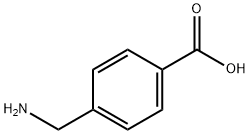Description
4-(Aminomethyl)benzoic acid is a organic compound that can serve as a type 2 antifibrinolytic agent used in the treatment of fibrotic skin disorders, such as Peyronie's disease. It is believed that 4-(Aminomethyl)benzoic acid is effective to increase the oxygen uptake at the tissue level and enhance activity of monoamine oxidase, thus to promote the degradation of serotonin, which in excess, may lead to fibrotic changes. It is also administrated by mouth to treat several skin conditions including vitiligo, pemphigus, dermatomyositis, morphea, lymphoblastoma cutis and scleroderma. It is sometimes used in pill form by patients suffering from irritable bowel syndrome to treat the relevant gastrointestinal symptoms and applied in nutritional epidemiological studies to assess the completeness of 24-hour urine collection for the determination of urinary sodium, potassium, or nitrogen levels. Besides, it can also serve as nutritional supplements to darken gray hair, prevent hair loss, make skin look younger and prevent sunburn and its benefits are claimed for people with fatigue, irritability, depression, weeping eczema, scleroderma, patchy pigment loss in skin, and premature grey hair.
References
https://en.wikipedia.org/wiki/4-Aminobenzoic_acid
https://www.alfa.com/en/catalog/B23519/
https://pubchem.ncbi.nlm.nih.gov/compound/4-aminobenzoic_acid#section=Top
http://www.webmd.com/vitamins-supplements/ingredientmono-1004-PABA+PARA-AMINOBENZOIC+ACID+PABA.aspxactiveIngredientId=1004&activeIngredientName=PABA
Chemical Properties
white to light yellow crystal powde
Uses
4-(Aminomethyl)benzoic acid (PAMBA) can be used in the synthesis of:
- Cobalt carboxy phosphonates.
- Apoptozole (Az), which has cellular potency to promote membrane trafficking of mutant cystic fibrosis transmembrane conductance regulator (CFTR) chloride channel activity.
- Cyclopeptide composed of L-glutamic acid and 3-aminobenzoic acid that can be used as receptors for a variety of cations and anions.
- A bioactive peptide which has potent GPR54 (a G protein-coupled receptor) agonistic activity.
Uses
4-(Aminomethyl)benzoic Acid is a type 2 antifibrinolytic agent.
Uses
4-(Aminomethyl)benzoic acid acts as an unnatural amino acid derivative. It is also used as a type 2 antifibrinolytic agent. Further, it reacts with 2-methyl-isothiourea sulfate to prepare 4-guanidinomethylbenzoic acid.
Definition
ChEBI: Aminomethylbenzoic acid is a member of benzoic acids.
reaction suitability
reaction type: solution phase peptide synthesis




